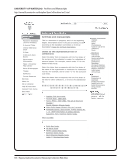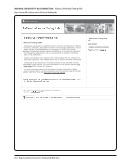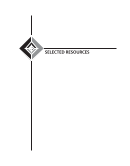SPEC Kit 307: Manuscript Collections on the Web · 101
Increases use of the collections by
making their information more visible.
Once we implement DLXS researchers
will be able to do cross-collection
finding aid searching across several
units.
Make collections more accessible.
Making our finding aids/collections
available to all.
Much higher visibility for collections and
increased use.
Online access enhances the visibility
of Penn State Special Collections
in general, promoting awareness
of unique Libraries’ resources. We
are partners in the ArchivesGrid site
which reciprocally enhances access to
resources for Penn State researchers.
More users find collections and there is
more use of existing holdings.
There is the potential for more users to
complete reference work before they
come into the Libraries. We have not
assessed this in any way.
Over time, will allow primary users to
conduct at least preliminary research
off site.
Assist staff in locating and retrieving
materials consistently.
Remote access. Preservation of information. Improved findability and searching.
Remote access 24/7. Digital content is harvestable and
machine searchable.
Digital content can be sliced and
diced and combined with other digital
content in unimaginably numerous
ways.
Researchers benefit from advance
access to finding aids and can make
their onsite visits more productive our
reading room remains very busy and
many researchers approach the desk
with printouts from the finding aid in
hand.
Library’s holdings are well publicized
in our online catalog, by inclusion in
the online catalog (with links from the
catalog records to the online finding
aids), and by inclusion in ArchiveGrid.
Online access, with the ability to search
across collections, increases usability of
the finding aids and facilitates research
discovery and use of our material.
Researchers find the finding aids via
Google searches and learn about
materials we own that they were not
aware of.
Web finding aids help researchers
determine more readily of collections
may hold information in which they’re
interested and be specific in requesting
boxes and folders.
Scholars worldwide have greater access
to our collections.
Because our finding aids are so
detailed, researchers have a very good
idea of just what documents are in each
folder.
Staff can consult online finding aids to
assist researchers on-site and off-site.
Increases use of the collections by
making their information more visible.
Once we implement DLXS researchers
will be able to do cross-collection
finding aid searching across several
units.
Make collections more accessible.
Making our finding aids/collections
available to all.
Much higher visibility for collections and
increased use.
Online access enhances the visibility
of Penn State Special Collections
in general, promoting awareness
of unique Libraries’ resources. We
are partners in the ArchivesGrid site
which reciprocally enhances access to
resources for Penn State researchers.
More users find collections and there is
more use of existing holdings.
There is the potential for more users to
complete reference work before they
come into the Libraries. We have not
assessed this in any way.
Over time, will allow primary users to
conduct at least preliminary research
off site.
Assist staff in locating and retrieving
materials consistently.
Remote access. Preservation of information. Improved findability and searching.
Remote access 24/7. Digital content is harvestable and
machine searchable.
Digital content can be sliced and
diced and combined with other digital
content in unimaginably numerous
ways.
Researchers benefit from advance
access to finding aids and can make
their onsite visits more productive our
reading room remains very busy and
many researchers approach the desk
with printouts from the finding aid in
hand.
Library’s holdings are well publicized
in our online catalog, by inclusion in
the online catalog (with links from the
catalog records to the online finding
aids), and by inclusion in ArchiveGrid.
Online access, with the ability to search
across collections, increases usability of
the finding aids and facilitates research
discovery and use of our material.
Researchers find the finding aids via
Google searches and learn about
materials we own that they were not
aware of.
Web finding aids help researchers
determine more readily of collections
may hold information in which they’re
interested and be specific in requesting
boxes and folders.
Scholars worldwide have greater access
to our collections.
Because our finding aids are so
detailed, researchers have a very good
idea of just what documents are in each
folder.
Staff can consult online finding aids to
assist researchers on-site and off-site.








































































































































































































